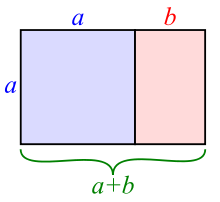The national flag of Togo consists of five horizontal stripes, alternating between green and yellow, with a red square bearing a five-pointed white star in the canton. It is one of many African flags that use the pan-African colours of green, yellow, and red. It was designed by Togolese artist Paul Ahyi in 1960, just before its adoption on 27 April of that year, coinciding with Togo's proclamation of independence. When Togo was an autonomous republic within the French Union (the successor to the French colonial empire), it flew a green flag with the French tricolour in the canton and two five-pointed yellow stars, one in the lower hoist and one in the upper fly.
Design
The design of the flag is outlined in Title I, Article 3 of the Constitution of Togo, 1992 (2019 revision). It states:[1]

The flag of Togo is a golden rectangle because its side lengths are in the golden ratio (represented by the Greek letter phi, 𝜑). In other words, its width-to-length ratio is 1:𝜑, where 𝜑 = 1+√5/2 ≈ 1.618.[2][3]
The flag was designed by Togolese artist Paul Ahyi (1930–2010), once described as the "African Picasso" and regarded as among the greatest of African artists of his generation.[4] Ahyi studied art in France and graduated from the École nationale supérieure des beaux-arts in Paris in 1959 before returning to Togo. The following year, he designed the flag of Togo, which was adopted upon the country's proclamation of independence on 27 April 1960.[5][6]
Symbolism
The flag uses the pan-African colours of green, yellow, and red. Its five stripes represent the five regions of Togo.[7] The office of the Togolese president gives the following significance to the flag's colours and symbols: green represents forests, agriculture, and hope; yellow represents natural resources, faith, and maturity; red represents the blood shed by those who fought for Togolese independence; and the white star represents peace, intelligence, and light.[6]
Historical flags

During the colonial era, Togo flew the flag of its colonial ruler: Germany from 1884 to 1914 (as part of German Togoland) and France from 1916 to 1960.[8][9] The United Nations trusteeship system established after World War II obliged France to move Togo (then French Togoland) towards self-government. Togo was made an autonomous republic within the French Union and a local flag was adopted in 1956.[7] The flag was a green field with the French tricolour in the canton and two five-pointed yellow stars, one in the lower hoist and one in the upper fly. The green field represented agriculture, hope, and youth, while the two stars represented Togo's northern savannas and southern coastal plains.[7]
See also
References
Citations
- ^ Constitution of Togo 2019, Title I, Article 3.
- ^ Posamentier & Lehmann 2011, pp. 53–54.
- ^ Johar 2024, p. 286.
- ^ Le Télégramme 2010.
- ^ Roussel 2020.
- ^ a b Government of Togo 2021.
- ^ a b c Smith 2001.
- ^ Knoll 1978, p. 22.
- ^ Minahan 2009, p. 928.
Sources
Books
- Johar, Syafiq (4 January 2024). "Some Applications of Real Sequences". The Big Book of Real Analysis: From Numbers to Measures. Springer Nature. pp. 263–296. ISBN 978-3-031-30832-1.
- Knoll, Arthur J. (1978). Togo Under Imperial Germany, 1884–1914: A Case Study in Colonial Rule. Hoover Institution Press. ISBN 978-0-8179-6091-9.
- Minahan, James B. (23 December 2009). The Complete Guide to National Symbols and Emblems: [2 volumes]. Bloomsbury Publishing USA. ISBN 978-0-313-34497-8.
- Posamentier, Alfred S.; Lehmann, Ingmar (20 December 2011). The Glorious Golden Ratio. Prometheus Books. ISBN 978-1-61614-424-1.
News articles
- "Décès de Paul Ahyi, le Picasso africain" [Death of Paul Ahyi, the African Picasso]. Le Télégramme (in French). 5 January 2010. Archived from the original on 19 July 2011.
- Roussel, Jane (14 January 2020). "Paul Ahyi : ce musée qui lui est dédié à Lomé" [Paul Ahyi: This Museum Dedicated to Him in Lomé]. Le Point (in French).
Government publications
- "Constitution du Togo, 1992" [Constitution of Togo, 1992]. Digithèque MJP (in French). Lomé: Government of Togo. 2019 [14 October 1992]. Archived from the original on 7 June 2021.
- "Les symboles de la république Togolaise" [The Symbols of the Togolese Republic]. Presidency of the Togolese Republic (in French). Lomé: Government of Togo. 2021.
Websites
- Smith, Whitney (16 February 2001). "Flag of Togo". Encyclopædia Britannica. Encyclopædia Britannica, Inc.
External links
 Media related to Flags of Togo at Wikimedia Commons
Media related to Flags of Togo at Wikimedia Commons- Togo at Flags of the World



Recent Comments